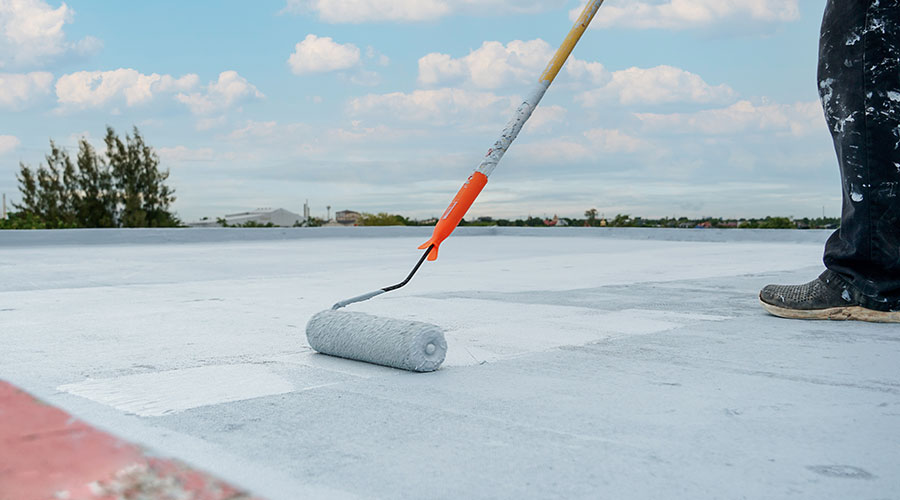Making white coatings work
Successful selection and application means understanding coatings’ materials and formulation
The two main purposes of white coatings are to protect roof membranes, resulting in longer roof life cycles, and to reflect solar radiation, resulting in lower energy costs. A closer look at their formulations and components can go a long way in helping managers successfully specify and apply coatings and ensure maximum performance.
Binders, pigments, liquid carriers
In general, a white coating consists of a binder blended with pigments and other additives. Maintenance managers have literally hundreds of different white coating products formulated and manufactured by a range of companies. Most can be conveniently classified according to the binder they use.
Binders usually are made of an organic or silicone compound. Most binders are elastic polymers with elongation and tensile characteristics, or elastomers, which can return to their original shape after being stretched or deformed.
In white coatings, the elastomer binder is the viscous, pliant material that bonds pigments and makes them adhere to the surface. Common elastomers used as binders in white coatings include acrylic, silicone, rubber, vinyl and urethane.
Titanium dioxide and zinc oxide are common pigments that give coatings their bright white color, but manufacturers combine other pigments to yield a variety of pastel colors.
Most white coatings used today are water-based - often referred to as latex coatings - and are available in a variety of polymer types. Water in latex coatings serves as a liquid carrier, allowing applicators to spread the pigment and binder onto the surface as a thin coating.
For some white coatings, organic solvents carry the liquid, while others, called reactive coatings, might flow well enough to eliminate the need for a liquid carrier. Reactive coatings generally are prepared with multiple-part resins blended on site before curing.
Membrane Compatibility
Managers can specify white coatings for use on most roofing membranes and systems. They most commonly are applied to sprayed polyurethane roofs, metal roofs, single-ply rubber roofs, and modified bitumen roofs. But they can be applied to certain kinds of asphalt built-up roofs.
Prior to specification, managers will need to establish the compatibility between the coating and the underlying roof surface. They can do this by consulting manufacturer recommendations.
Primers and Surface Preparation
Primers are useful for improving the adhesion between roof surfaces and coatings and for imparting additional properties to roof coating systems. A compatible primer for a rubber roof coating might provide better adhesion to a rubber roof membrane or improve a coating’s permeability rating on a sprayed polyurethane roof.
Most white coatings give a system greater reflectivity and ultraviolet (UV) protection. Managers should consult and follow manufacturer recommendations to ensure workers properly prepare the surface, and they should consider using professional roofing contractors for coating applications. For certain systems, contractors might require special training from the manufacturer in applying the coating. Proper application factors strongly into the subsequent life and performance of the coating.
The roof surface should be clean and dry, and it must have a positive slope to drains. The coating type will greatly dictate the necessary surface condition. Applying white coatings over dirty, wet or contaminated surfaces might produce unsatisfactory results, and acrylic latex coatings are sensitive to dew, rain and other moisture during curing. It is important that workers apply the coating by strictly adhering to manufacturer recommendations.
Application Insights
Coating applicators typically use airless sprayers, rollers or brushes. Due to the variety of coating types, climactic conditions and surfaces to be coated, it is important to consult the manufacturer for proper application rates and related recommendations.
Many, but not all, white coatings are waterproof. A coating's permeability — its perm rating — to liquid water, water vapor, and gases varies greatly, depending on the coating type:
-
Acrylic coatings are breathable, so they have a high moisture-vapor transmission rate, or permeability.
-
Silicone coatings are classified as breathable.
-
Butyl rubbers, hypalons and neoprenes have very low permeability, so they are highly resistant to moisture transmission.
Specifiers should not confuse a coating’s perm rating with its weather resistance. A coating with low permeability still might require a protective topcoat to ensure satisfactory resistance to weather.
Cleanliness and Aging
Roofs covered by white coatings and located in arid and dusty regions, or in places where farm plowing or construction exposes the earth to wind, are likely to accumulate dirt more quickly than roofs in areas with greenery or where occasional rainfall washes away dirt.
The frequency and intensity of precipitation, along with the slope of the roof, also affect the cleanliness of coatings over time. As with other white surfaces, white coatings can discolor and darken slightly after several years of service.
Generally, a small decrease in reflectivity occurs over time, depending on several factors. Wind-blown dirt and dust can decrease the reflectivity of white coatings, depending on the coating’s age and regional climate characteristics.
A white coating tends to block, rather than reflect, UV radiation. A white coating still protects against UV radiation, even when foreign particles reduce its reflectivity.
To maintain coatings’ reflectivity, managers might periodically schedule a new topcoat to refresh the surface. This typically costs less than the initial coating.
A coating’s maintenance schedule depends on its type, as well as the type of roof, the purpose of the coating, and regional climate differences. Typically, workers should refresh white coatings every three to seven years in order to receive their maximum benefits.
These recommendations are not intended to revoke or change the requirements or specifications of individual roofing material manufacturers or local, state and federal building officials that have jurisdiction. Managers should direct questions about a coating’s requirements or specifications to the product's manufacturer.
Information for this article is adapted from a technical note written by the Roof Coatings Manufacturers Association (RCMA).
Related Topics:











